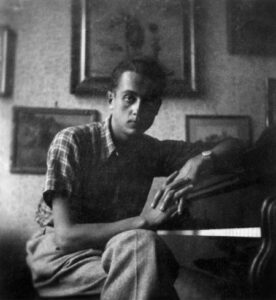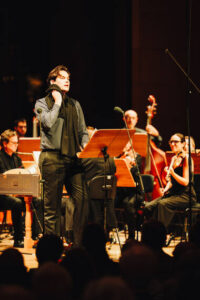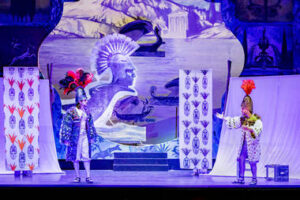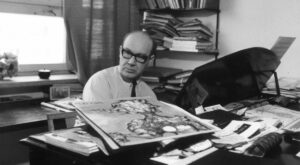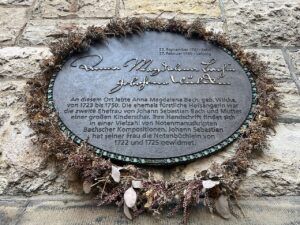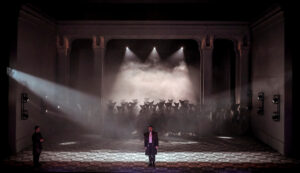Muzyka do nieistniejących filmów
A przed obiecaną recenzją z końcówki tegorocznych Bayreuther Festspiele jeszcze jedna wycieczka do archiwum. Esej, który podobnie jak opublikowany wcześniej tekst o śląskich tradycjach muzycznych ukazał się najpierw w nieistniejącym już magazynie „KTW”, później w „Glissandzie”, a teraz postanowiłam go udostępnić czytelnikom Upiora. To był jednak kompozytor niezwykły.
***
Kiedy umarł Kilar – 29 grudnia 2013 roku – uczyniłam to, co najpewniej zrobiła większość moich kolegów po fachu: usiadłam do komputera i zaczęłam przekopywać zasoby sieciowe, szukając w nich czegokolwiek poza naprędce skleconymi nekrologami oraz informacjami o przyznaniu Orderu Orła Białego, otrzymaniu honorowego członkostwa Światowego Kongresu Kresowian bądź odebraniu medalu „Per artem ad Deum” na kieleckich targach Sacroexpo. Polscy specjaliści od muzyki współczesnej już od dawna podchodzili z niejaką konsternacją do recenzowania kolejnych prawykonań utworów Kilara. Proszeni o komentarz, czym tłumaczyć sympatię kompozytora do Radia Maryja albo jak zinterpretować jego poparcie dla Jarosława Kaczyńskiego w przedterminowych wyborach prezydenckich po katastrofie w Smoleńsku, uciekali oczyma w bok i przypominali sobie z nagła, że zostawili w domu włączone żelazko. Po śmierci osiemdziesięciojednoletniego twórcy zachowywali się podobnie, deklarując na blogach i Facebooku, że nie wezmą udziału w żadnej dyskusji i nie zamierzają odnosić się do spuścizny kompozytora, który w najlepszym razie pisał dobrą muzykę filmową, a któremu – pospołu z Góreckim i Pendereckim – dostało się już od Kisiela, oskarżającego całą trójkę o uprawianie „socrealizmu liturgicznego”, później zaś od Doroty Szwarcman, autorki nośnego pojęcia „muzyka szantażu moralnego”.
Po kilku minutach poszukiwań „wyguglałam” rozmowę Mój solidny świat, przeprowadzoną z Kilarem przez Ewę Niewiadomską, w dodatku „Tygodnika Powszechnego” poświęconym nowo powstałej instytucji Katowice: Miasto Ogrodów. Niewiadomska docieka, czy Kilar zgadza się z tezą, że Górny Śląsk przyciąga i zatrzymuje u siebie wspaniałych kompozytorów. Kilar wymienia Góreckiego, Knapika, Lasonia, Świdra, Krzanowskiego, Bogusławskiego i Szalonka, po czym się zastrzega, że mógł o kimś zapomnieć. Na pytanie o związki łączące ich twórczość, Kilar odpowiada: „W jednym z ostatnich »Tygodników Powszechnych« Dorota Kozińska pisze o tzw. szkole śląskiej, a o mnie i Góreckim jako o »dwóch awangardzistach, którzy już w latach 70. wykonali potężną woltę. Jakby przeczuwając nadejście wielkich zmian społecznych i tryumf ponowoczesnej pamięci zbiorowej, wymagającej operowania językiem prostym, podniosłym, pełnym symboli, odniesień i metafor także w sferze muzycznej«. Myślę, że ten opis jest trafny”.
Wojciech Kilar w młodości. Zdjęcie z archiwum rodzinnego
Odjęło mi mowę. Nie spodziewałam się w najśmielszych snach, że Kilar kiedykolwiek przywoła moją opinię, a co więcej, uzna ją za trafną. Zrobiło mi się zwyczajnie głupio, bo zacytował fragment artykułu o nadchodzącej premierze VIVO XXX, utworu, który Paweł Mykietyn skomponował na zamówienie Festiwalu Solidarity of Arts w Gdańsku z okazji trzydziestolecia Solidarności. Artykułu Pamięcią silni, w którym pisałam o budowaniu „mitu założycielskiego”, o Czesławie Miłoszu, mimowolnym Wernyhorze polskiego ruchu robotniczego, i właśnie o przewrocie stylistycznym w twórczości kilku kompozytorów, których już tylko o kicz oskarżyć nie można, bo w postmodernizmie to jeden ze środków wyrazu artystycznego. Ja tu sobie dworuję, a Kilar śmiertelnie poważnie przyznaje mi rację. Koledzy po fachu uznali, że kompozytor nie wyczuł w moich słowach ironii. A ja sobie teraz myślę, że nawet jeśli ją wyczuł, to zupełnie się nią nie przejął. Bo Kilar od zawsze – nie od czasu słynnej iluminacji religijnej, jakiej doznał w 1980 roku, stanąwszy twarzą w twarz z ikoną Czarnej Madonny na Jasnej Górze – był kompozytorem i człowiekiem osobnym, nieledwie mizantropem, który pisał co chciał i jak chciał, a potem już tylko marzył, żeby wszyscy dali mu święty spokój.
Bo tak naprawdę, Kilar nie był nigdy ani awangardzistą, ani socrealistą liturgicznym, ani twórcą muzyki religijnej z prawdziwego zdarzenia, ani nawet przedstawicielem postmodernizmu. Przez całe życie – jak słusznie podkreśla krytyk i kompozytor Rafał Augustyn, uczeń Góreckiego – był twórcą środka, który chciał pisać muzykę wzruszającą i „porywną”, pełną szczerych emocji, komponowaną najlepiej, jak umiał. Wbrew temu, co próbuje nam się wmawiać, zwłaszcza po jego śmierci, nie był kompozytorem światowej sławy. Zawsze jechał o kilka długości za peletonem tytanów polskiej szkoły kompozytorskiej, w którym znaleźli się nie tylko Lutosławski, Penderecki i Górecki, ale też Serocki, Baird i Bacewicz. Twórczość Kilara zawsze była prostsza, bardziej tradycyjna w założeniach, niestroniąca od swojskości, folkloru, odniesień do minionych epok i estetyki „z pogranicza”. W słynnym utworze Riff 62 – wykonanym po raz pierwszy na Warszawskiej Jesieni w 1962 roku i chwilę potem bisowanym od początku do końca – upatrywano manifest przyszłości, sonorystyczny symbol sprzeciwu wobec tradycji zastanej. Tymczasem już w tej, przełomowej rzekomo kompozycji, tkwi zalążek późniejszej twórczości Kilara: ów tytułowy, zaczerpnięty z jazzu „riff”, czyli powtarzana do upadłego fraza lub motyw melodyczno-harmoniczny. Rok późniejsze Générique, obfitujące w najróżniejsze szmery, trzaski, klaksony i klastery, znów zdradza cechy kompozycji świetnej warsztatowo, ale mimo wszystko niezbyt oryginalnej, niby nowoczesnej w kształcie dźwiękowym, ale jednak podejrzanie uwodzicielskiej brzmieniowo. A już Upstairs-Downstairs na dwa chóry dziecięce i orkiestrę (1971) zapowiadało gwałtowny odwrót od coraz bardziej obcej Kilarowi awangardy – w stronę tonalności, choć wciąż jeszcze przełamanej sonorystyczną harmoniką „ciasnych” współbrzmień w klasterach.
Kilar w zaciszu domowym. Fot. Bartek Barczyk
W 1974 roku Kilar walnął pięścią w stół i postawił wszystko na jedną kartę. Wygrał. Kiedy w Filharmonii Narodowej po raz pierwszy rozbrzmiał Krzesany – bezwstydnie określony jako poemat symfoniczny, czerpiący garściami z folkloru, pod względem fakturalnym prosty jak drut, oparty na motywie złożonym z trzech akordów na krzyż – w szeregach znużonych awangardą krytyków wybuchł dziki entuzjazm. „Apologia góralszczyzny, przy której blednie słynny balet Karola Szymanowskiego”, zachwycał się Andrzej Chłopecki. „Kolorowy wykrzyknik na tle warszawsko-jesiennej szarości”, piał Olgierd Pisarenko. Spodobało się, to dostali jeszcze. Bogurodzicę na chór mieszany i orkiestrę (1975), która wstrząsnęła Bohdanem Pociejem, nie powstrzymała go wszakże od refleksji, że architektonika tego utworu jest uderzająco prosta, a melodyka wokalna – skrajnie zredukowana. Kościelec 1909, kolejny poemat symfoniczny (1976), tym razem nawiązujący nie tylko do folkloru tatrzańskiego, ale też do spuścizny Mieczysława Karłowicza, co trochę zbiło z tropu krytyków, coraz częściej przebąkujących pod nosem o „radykalnym eklektyzmie” Kilara. Siwą mgłę (1979), która siadła na Giewoncie i przesłoniła juhasowi drogę do dziewczyny – z programowym komentarzem orkiestry do tekstu poszczególnych zwrotek góralskiej śpiewki wykonywanej przez baryton. Krytycy zaczęli się wiercić w fotelach. Wreszcie Exodus z 1981 roku, zwany celnie, acz złośliwie Bolerem Kilara. Leszek Polony raportował po prawykonaniu, że: „Publiczność, zrazu skonsternowana ustawicznym powtarzaniem akordu E-dur (rozległy się nawet pojedyncze śmiechy), została ostatecznie porwana siłą i dynamizmem kompozycji”. Skonsternowani krytycy i koledzy Kilara po fachu ostatecznie nie dali się porwać, ani siłą, ani tym bardziej dynamizmem. Rafał Augustyn wspomina jednak wypowiedź innego śląskiego twórcy, Eugeniusza Knapika, który kilka lat później wzdychał: „Przy niektórych utworach chce się zaprotestować: »No, Wojtek, nie, to już przesada, tak nie można…!«. Tymczasem jest wielu ludzi, których ta muzyka wzrusza i porywa”.
I tak już zostało. Po Exodusie nadszedł Angelus, po nim Orawa i Preludium, dalej kompozycje nie tyle nawet religijne, co ściśle liturgiczne: Missa pro pace na nowe tysiąclecie, a zarazem na stulecie Filharmonii Narodowej, oraz dedykowany żonie Magnificat z 2006 roku, o którym Kilar powiedział kiedyś: „To jest moje podziękowanie Panu za życie i za wolną Polskę. Także za to, że możemy się tutaj kłócić, spierać, awanturować nawet bez zezwolenia Wielkiego Brata. »Wielkie bowiem rzeczy uczynił nam Wszechmocny«. Wierzę w to, że jest jakiś plan Boży, który się teraz realizuje”. Wobec takiej deklaracji światopoglądowej zamilkli niemal wszyscy. Ci, których Kilar – głoszący swe nowe muzyczne credo z ewangeliczną niemal prostotą – wzruszał i porywał, zamilkli z zachwytu. Inni zamilkli w poczuciu głębokiego zażenowania. Zasadniczo z tych samych powodów. Kilar nie przejął się ani jednymi, ani drugimi. Pogrzebawszy błędy młodzieńczego wieku na „wielkim cmentarzu partytur awangardy”, robił dalej swoje, w niezmiennym poczuciu własnej wartości, które jednak nigdy nie przerodziło się w pychę.
Żeby zachować twarz, specjaliści od muzyki współczesnej upchnęli go w szufladkę z napisem: „wybitny kompozytor muzyki filmowej”. Istotnie, stworzył jej mnóstwo, z kilkoma reżyserami, przede wszystkim z Zanussim i Wajdą, związał się wręcz emblematycznie. Leszkowi Polonemu wyznał kokieteryjnie, że „zaczął pisać do filmu troszeczkę z chciwości”. Wiele jednak wskazuje, że robił to z gorącej, spełnionej dopiero w słusznym wieku miłości do Hollywood, do fenomenu rzeczywistości zaklętej w technikolorze, do wszystkiego, co temu skądinąd bardzo poważnemu człowiekowi pozwalało zachować w sobie choć odrobinę dziecka. I choć w Polsce nie chodziło się do kina po to, żeby obcować z muzyką Kilara, w tym gatunku tworzył prawdziwe arcydzieła. Zamiast przerzucać się cytatami z inżyniera Mamonia i fałszywego kaowca, warto choćby raz wsłuchać się w pokiereszowany walczyk z Rejsu Piwowskiego. Albo uświadomić sobie, że gdyby nie zamaszysty, całkiem już poważny walc z Ziemi obiecanej Wajdy, Francis Ford Coppola być może nie zaproponowałby Kilarowi współpracy przy swoim Draculi. Kino Zanussiego (m.in. Iluminacja, Kontrakt, Bilans kwartalny i Hipoteza, w sumie ponad czterdzieści wspólnie zrealizowanych projektów filmowych) było na pewnym etapie nierozłącznie związane z tą muzyką. Kilar nie czekał na propozycje; zaprzyjaźniony ze światkiem polskiej kinematografii, sam chodził po reżyserach i prosił, żeby dorobili mu film do partytury. Tak ponoć powstała Kronika wypadków miłosnych Wajdy. Ciekawe, jak potoczyłyby się losy starszego już kompozytora, gdyby zgodził się pracować w iście amerykańskim tempie i przyjął najbardziej lukratywną z propozycji Hollywood: napisania ścieżki dźwiękowej do legendarnej już trylogii Władca Pierścieni w reżyserii Petera Jacksona. Jakkolwiek na to patrzeć, Kilar odszedł przede wszystkim w chwale kompozytora filmowego. Minister Zdrojewski pożegnał go słowami: „był polską perłą w koronie muzyki światowej”. Skojarzenia z tytułem drugiej części dyptyku śląskiego Kutza – całkowicie nieprzypadkowe.
Jubileusz osiemdziesięciolecia kompozytora w Filharmonii Narodowej. Fot. Grzegorz Jakubowski
Jego ostatnie utwory, m.in. II Koncert fortepianowy z 2011 roku – z którego kompozytor, w przeciwieństwie do krytyków, był bardzo zadowolony – zdradzają już wszelkie cechy „późnego” Kilara: skrajne uproszczenie języka, znamienną powtarzalność fraz i motywów, długie płaszczyzny harmoniczne, wywołujące wrażenie zatrzymania czasu. Najkrócej rzecz ujmując, brzmią jak muzyka filmowa. Jakby Kilar nieustannie pragnął, żeby ktoś wziął jego nuty i zrobił do nich kawał porządnego kina. A może zawsze tak było? Może Kilar już w młodości marzył o karierze w Fabryce Snów, i tylko sytuacja geopolityczna sprawiła, że musiał wpierw przejść wszelkie kompozytorskie choroby, na które w Polsce nie dało się zaszczepić? Wszystkie te neoklasycyzmy, sonoryzmy, folkloryzmy, eklektyzmy z elementami religijno-patriotycznymi? Żeby w końcu napisać muzykę do filmu, jakiego świat jeszcze nie widział?
Dwa lata po śmierci ukochanej żony Barbary, w wywiadzie dla tygodnika katolickiego „Niedziela”, Kilar opisywał spotkanie ich dwojga: „Coś mnie w tej sylwetce zafascynowało i można powiedzieć, że była to miłość od pierwszego wejrzenia. To prawdziwe zrządzenie Bożej Opatrzności porównuję do pioruna, jak w Ojcu Chrzestnym”. Skoro nawet we wspomnieniu tak znamiennej chwili Kilar posłużył się metaforą wywiedzioną z arcydzieła Francisa Forda Coppoli, chyba coś jest na rzeczy.

